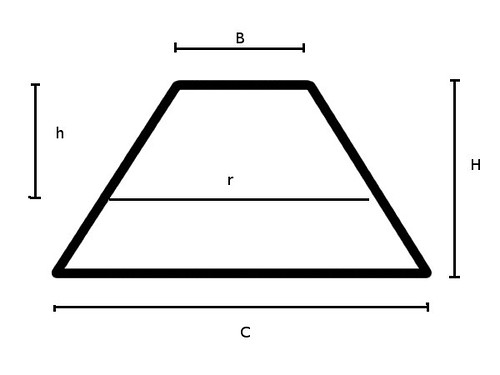I guess he only knits rectangles.
I get lots of blog hits from folks looking for shawl calculation help. Many people knitting a triangular shawl from the top down want to know how many pattern repeats they can finish before they run out of yarn. I gave a method (using algebra) in this post and a follow-up in this post.

I recently started Ene's Scarf, my first triangular scarf/shawl knit from the bottom up. Meaning: cast on a terrific number of stitches, then decrease regularly until they are almost all gone, bind them off and block out to triangular shape.
Again, this isn't really a triangle, but a trapezoid. Cast on 375 stitches, decrease two stitches per row until you are left with 19 stitches, then do a bind-off that grafts them together.
This time, I know I have enough yarn. (Elsebeth Lavold's Silky Wool. Purchased to make Cozy from knitty.com, frogged for a variety of reasons.) All I really want to know is when I have reached the halfway point for the psychological assurance. However, if I were worried about having enough yarn, I would use the same calculations --- but factoring in the extra yarn used in the cast-on row more carefully.
First: Draw a picture and determine what I know and what I want to know.

For Ene's Scarf:
C = cast on = 375 stitches
B = end (not exactly bind-off, but close enough) = 19 stitches
H = number of rows = 179
note that if one really does decrease two stitches per row, the numbers are a teeny bit off -- one would end up with 17 stitches. That's because in this pattern, there are a few rows that don't follow the rules completely, but the difference is negligible for my needs.
Total number of stitches = Area of trapezoid = 1/2(C+B)*H = 35,263
I know that I will have knit half the scarf when I reach row h with r stitches where the area of the top trapezoid with base r is exactly half the area of the whole trapezoid.
I have two unknowns, h and r. Fortunately, I can solve for r in terms of h, so I will end up having an equation with one unknown and I can solve it.
h = rows left to finish
r = number of stitches in the row where there are h rows left.
So r = 19 + 2h
Area of top trapezoid is 1/2(19 + r) * h = 1/2(19 + 19 + 2h)h = 19h + h²
So we have to solve for h where
19h + h² = 1/2(35,263) = 17,631.5
h² + 19h - 17,631.5 = 0 is a quadratic equation, easily solved by the Pythagorean Theorem.
Do you want to see the calculations? I thought not. But I'll show you anyway. There are two real solutions to this equation, but we are only interested in the positive solution. Therefore, we only care about
(-19 + (19² - 4 * (-17,631.5))^.5) / 2 = 124 (more or less)
I will be halfway done when I have 124 rows left. 179 rows total, means I will be halfway done when I have finished 55 rows.
